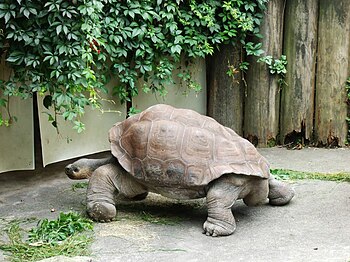Tortoise: Difference between revisions
Pat Palmer (talk | contribs) mNo edit summary |
Pat Palmer (talk | contribs) mNo edit summary |
||
| (4 intermediate revisions by the same user not shown) | |||
| Line 1: | Line 1: | ||
{{subpages}} | {{subpages}} | ||
{{Image|Tortoise | {{Image|Tortoise 21.jpg|right|350px|A tortoise.}} | ||
A '''tortoise''' is a potentially very long-lived, | A '''tortoise''' is a potentially very long-lived, plant-eating [[reptile]] of the order ''Chelonia''. It is closely related to the terrapin<ref name=ter /> and the turtle<ref name=tur /> which are marine and freshwater species of the same order. The tortoise is a common household pet in Great Britain. It hibernates during the cold seasons and is active in summer, generally enjoying gardens with a sunny aspect. | ||
Tortoises have a shell, their most characteristic feature, which is a curved upper ''carapace'' adjoined at the sides to a flattened lower ''pastron''. Their front foot is usually a stumpy leg, not a flipper for swimming as may be seen on turtles and terrapins, which also have a flatter carapace. Tortoises can withdraw their head and limbs into the shell for protection. Being herbivorous, the tortoise has not no teeth but it does have a sharp-edged beak and can inflict a nasty bite. Pet tortoises are generally fed on [[salad]] items like lettuce or [[chicory]], as well as specially prepared foods to provide [[vitamin]]s. In the garden, they eat [[grass]] and | Tortoises have a shell, their most characteristic feature, which is a curved upper ''carapace'' adjoined at the sides to a flattened lower ''pastron''. Their front foot is usually a stumpy leg, not a flipper for swimming as may be seen on turtles and terrapins, which also have a flatter carapace. Tortoises can withdraw their head and limbs into the shell for protection. Being herbivorous, the tortoise has not no teeth but it does have a sharp-edged beak and can inflict a nasty bite. Pet tortoises are generally fed on [[salad]] items like lettuce or [[chicory]], as well as specially prepared foods to provide [[vitamin]]s. In the garden, they eat [[grass]] and dandelions, among other things. | ||
Perhaps the best known species among small tortoises is the North African (''Testudo graeca'') which is also native to Asia Minor. The giant tortoise of the Galapagos Islands can be as much as four feet long and weigh over 200 pounds. | Perhaps the best known species among small tortoises is the North African (''Testudo graeca'') which is also native to Asia Minor. The giant tortoise of the Galapagos Islands can be as much as four feet long and weigh over 200 pounds. Giant tortoises in captivity have been known to live longer than 200 years, and some are believed to have lived 300 years. | ||
==Notes== | |||
<references> | |||
== | <ref name=tur> | ||
Read about [[Wikipedia:Turtle|turtles]] on Wikipedia. | |||
</ref> | |||
<ref name=ter> | |||
Read about [[Wikipedia:Terrapin|terrapins]] on Wikipedia. | |||
</ref> | |||
</references> | |||
Latest revision as of 07:39, 3 March 2024
A tortoise is a potentially very long-lived, plant-eating reptile of the order Chelonia. It is closely related to the terrapin[1] and the turtle[2] which are marine and freshwater species of the same order. The tortoise is a common household pet in Great Britain. It hibernates during the cold seasons and is active in summer, generally enjoying gardens with a sunny aspect.
Tortoises have a shell, their most characteristic feature, which is a curved upper carapace adjoined at the sides to a flattened lower pastron. Their front foot is usually a stumpy leg, not a flipper for swimming as may be seen on turtles and terrapins, which also have a flatter carapace. Tortoises can withdraw their head and limbs into the shell for protection. Being herbivorous, the tortoise has not no teeth but it does have a sharp-edged beak and can inflict a nasty bite. Pet tortoises are generally fed on salad items like lettuce or chicory, as well as specially prepared foods to provide vitamins. In the garden, they eat grass and dandelions, among other things.
Perhaps the best known species among small tortoises is the North African (Testudo graeca) which is also native to Asia Minor. The giant tortoise of the Galapagos Islands can be as much as four feet long and weigh over 200 pounds. Giant tortoises in captivity have been known to live longer than 200 years, and some are believed to have lived 300 years.
